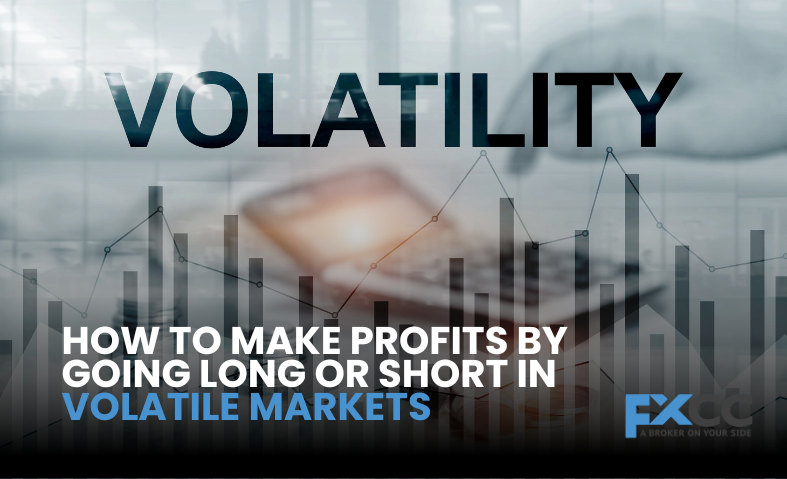Volatile markets are known for their unpredictable price swings, often causing anxiety among investors. However, they also present opportunities for those who know how to leverage these fluctuations. Strategies like going long or short can help you navigate the chaos and turn market movements into profit. Understanding these approaches and applying them wisely is the key to success.
Understanding Volatile Markets
Market volatility refers to significant price changes within a short timeframe. It is usually triggered by major events such as economic news, political developments, or unexpected announcements from companies. While volatility can lead to losses, it is also a fertile ground for traders who know how to act decisively. By capitalizing on these movements, you can generate profits whether the market is moving up or down.

What Does Going Long Mean?
Going long is the traditional method of investing. It involves purchasing an asset with the expectation that its price will rise over time. Essentially, you are betting on the growth of a stock or commodity. For instance, if you buy a stock at a lower price and sell it when the value increases, you pocket the difference as profit.
This strategy works best in markets that show consistent upward trends. Investors typically look for strong fundamentals, such as companies with growing revenues, innovative products, or expanding markets. Patience is often necessary when going long, as the rewards can take time to materialize.
How Does Short Selling Work?
Short selling, often referred to as “going short,” is a trading approach aimed at gaining from a decline in asset prices. It involves borrowing shares from a broker and selling them at the current price. Later, you repurchase the same shares at a lower price and return them to the broker, keeping the difference as your profit.
For example, if you sell a borrowed stock at $50 and buy it back at $40, you make a $10 profit per share. This approach is popular in bear markets, where declining trends dominate. However, short selling comes with high risks. If the price rises instead of falling, your losses can grow significantly, as there is no cap on how high a stock can climb.
Risks Associated with Long and Short Positions
Each strategy carries its own unique risks that traders must carefully assess before making a decision. When going long, the main danger is a sudden market downturn. If prices drop after you purchase a stock, you could face losses. This is particularly problematic if you’ve invested heavily in a single asset or sector.
Short selling, on the other hand, is inherently riskier. If prices rise instead of falling, you may be forced to buy back the stock at a much higher price, leading to substantial losses. Additionally, rapid price increases caused by a short squeeze can catch traders off guard. In such cases, many short sellers scramble to exit their positions, driving prices even higher and compounding the losses.
Tips for Trading in Volatile Markets
Success in volatile markets requires careful planning and strong decision-making. Before trading, it’s essential to analyze the market thoroughly. Researching economic indicators, industry trends, and specific company performance can help you identify opportunities.
Risk management is another crucial factor. Setting clear limits for losses and gains can prevent emotions from dictating your decisions. For example, using stop-loss orders can automatically close a trade if the price moves against you, minimizing potential losses.
Staying informed is equally important. Market conditions can change rapidly, and keeping an eye on real-time news and data is vital for timely decision-making. Traders who react quickly to developments often have a significant edge in volatile environments.
The Role of Leverage
With leverage, traders can manage significantly larger market positions while committing a smaller initial investment. While it can amplify your profits, it also increases your risk exposure. In volatile markets, this can be both an advantage and a disadvantage. Used wisely, leverage can help you capitalize on price swings. However, misuse can lead to significant losses, particularly if the market moves against you. It’s best to approach leverage with caution and ensure you fully understand the risks involved.
Choosing the Right Strategy
The choice between going long or short depends largely on your financial objectives, appetite for risk, and how you perceive market trends. Long positions are ideal for investors who believe in the long-term growth of an asset or market. This strategy aligns well with those who prefer a less risky approach and are willing to wait for returns.
Short selling, meanwhile, suits traders who thrive in fast-paced environments and have the expertise to identify overvalued assets. It requires a higher level of confidence and an appetite for risk. Experienced traders often use a combination of both strategies to hedge against market uncertainties and maximize profit opportunities.

Bottom Line
Volatile markets may seem intimidating, but they offer unique opportunities for traders willing to embrace the challenge. Whether you choose to go long, short, or a mix of both, the key is to remain informed, disciplined, and prepared for any outcome. By managing risks and staying focused on your strategy, you can turn market turbulence into a profitable venture.


